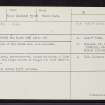Pricing Change
New pricing for orders of material from this site will come into place shortly. Charges for supply of digital images, digitisation on demand, prints and licensing will be altered.
South Uist, Daliburgh, Dun Ruadh
Dun (Prehistoric)(Possible)
Site Name South Uist, Daliburgh, Dun Ruadh
Classification Dun (Prehistoric)(Possible)
Canmore ID 9866
Site Number NF72SW 7
NGR NF 7379 2184
Datum OSGB36 - NGR
Permalink http://canmore.org.uk/site/9866
- Council Western Isles
- Parish South Uist
- Former Region Western Isles Islands Area
- Former District Western Isles
- Former County Inverness-shire
NF72SW 7 7379 2184.
(NF 737 92184) Dun Ruadh (NR) (Site of)
OS 6"map, Inverness-shire, 2nd ed., (1904)
All traces of Dun Ruadh have been removed.
RCAHMS 1928.
A mutilated, grass-covered, irregular mound, c 1.0m high, with a few large stones on top, is all that remains at this site.
Revised at 1/2500.
Visited by OS (W D J) 6 May 1965.
NF 733 336-NF 758 140 Almost half of the South Uist machair has been surveyed between 1993 and 1995, in a single stretch from West Kilbride in the extreme S of the island to the N of the Ard Michael promontory, a distance of 20km with the width of the machair averaging about 1km (see unpublished reports, Department of Archaeology, University of Sheffield). Existing RCAHMS records for prehistoric and early historic settlement sites number some 20 locations within this zone. The machair project has now increased this number to 81. Two of the RCAHMS sites, the broch/dun at Orosay (NF71NW 5) and the broch of Dun Ruaidh (NF 739 219), are misidentifications.
The area most responsive to field survey on the machair is the section between Kildonan and Stoneybridge, the N 5km portion of the survey area. Here, where most of the surviving machair plain has not been covered by dunes, some 44 sites have been recognised. along with a grouping of Late Neolithic/Early Bronze Age settlement mounds in the Kildonan area, the main settlement pattern is a set of clusters of Iron Age to Viking Age settlement mounds for each of the five townships. These Iron Age-Viking Age clusters may be viewed as predecessors to the township system first mapped in 1805 and still in use today.
A second concentration of sites has been found further S in the machair of Daliburgh and Kilpheder, where a total of 19 sites have been discovered in an area of 3 square kilometres. This density is all the more remarkable given the large extent of dune incursion on to the machair plain in this area. Within this zone two key house sites, both well preserved, have been excavated. One is Kilpheder wheelhouse (NF72SW 1) of Middle Iron Age date and the other is the Cladh Hallan double roundhouse (NF72SW 17) of Late Bronze Age date. The most remarkable feature of prehistoric settlement in this area is the 500m long string of Late Bronze Age/Early Iron Age settlement W of the modern cemetery. However, there is considerable potential for good preservation, as indicated by the 1994-95 excavations.
The results of the recent survey are by no means exhaustive but they do indicate a remarkable density of later prehistoric and early historic settlements on the machair. The pattern of proto-townships throughout the survey area holds reasonably well but there are gaps for the townships of Garrynamonie and Garryheillie.
Sponsor: Historic Scotland.
M Parker Pearson 1995.
Field Visit (31 August 1914)
Dun Ruadh (site of), Loch Hallan.
Between the graveyard near Daliburgh and Loch Hallan is the site of Dun Ruadh. All traces have been removed, and the ground is under cultivation.
RCAHMS 1928, visited 31 August 1914.
OS map: South Uist Iv.










